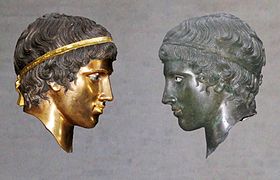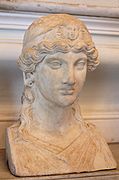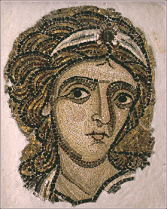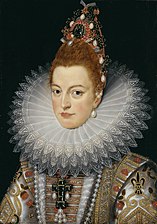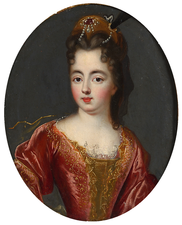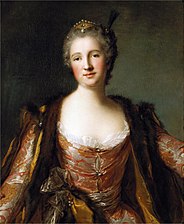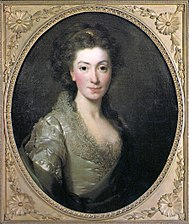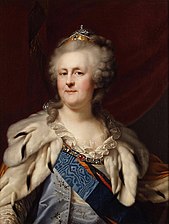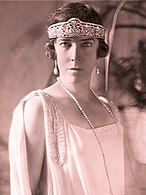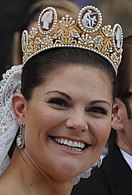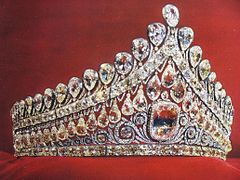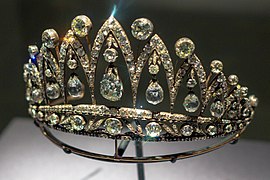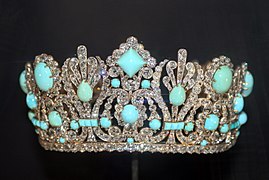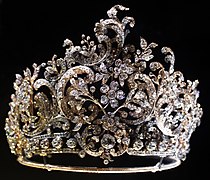diadem

A diadem (from the Greek διάδημα ( diádema ) = " forehead bandage") was used in ancient times as a narrow front bandage to hold the hair together; from the forehead band that was worn after a victory, the king band developed . There were also various wreaths ( Corona ), u. a. the laurel wreath , which was later made of gold. Already in ancient times the diadem was developed as a special type of crown in the form of a half or crescent- shaped forehead or head circlet, with an emphasis on the center of the forehead. This form of the diadem was and is still worn by women on festive occasions.
etymology
The word is borrowed from the Latin or Greek diadema . This is derived from the Greek dia-dein “to bind” and therefore literally means “to be bound”. There is also a relationship with the word demos (band). The word diadema is first documented by Xenophon in his description of the Persian royal robe (see below).
The English word for today's diadem as a typical female decorative crown is “ tiara ” - a typical ' false friend ' because the term tiara in German is reserved exclusively for the papal crown and the crown of ancient Persian rulers . In many other languages, such as French , Italian , Spanish , Danish , Swedish , Dutch etc., a derivation of the Greco-Latin word diadema is used just like in German .
history
Antiquity
With the Persians , the diadem was wrapped around the tiara or turban and was typically blue and interwoven with white. Tiaras made of gold or electrum were already worn in ancient Egypt, and rare specimens adorned with gold flowers or stars and gazelle heads have survived from the 18th dynasty (1550 to 1292 BC) .
Some gods of the Greeks were depicted adorned with a diadem, in particular Zeus and Hera . Greek women and young men - especially the Olympic winners - wore a band in their hair in ancient times. In Hellenistic times, at least since the Diadochi, the armband was the emblem of the dignity of the ruler ( king armband ). Whether the diadem of the Hellenistic kings can be traced back to Persian or Greek models is disputed. The Bacchic diadem ( Kredemnon ) consisted of a multiple- fold band that encircled the forehead and temple and was tied behind the head.
The diadem did not appear until later in the Roman Empire . The first emperors preferred not to wear a diadem so as not to irritate the people. Only with Diocletian (* between 236 and 245 - † 312) did the custom reappear. Diadems in the form of half crowns were worn by the wives of the Roman emperors since the 1st century.
- Tiaras in antiquity
so-called " Demeter Altemps ", Roman copy based on a Greek original from the 4th century BC. BC (Museo nazionale romano Palazzo Altemps , Rome).
Greek youth with headband, with and without gilding (exhibition "Colorful Gods" in the Glyptothek Munich)
Agrippina minor , 1st century, (Barcelona)
antique bust with diadem, approx. 98–117 AD ( Musei Capitolini , Rome)
Vibia Sabina , c. 135 AD (Musei Capitolini, Rome)
During the reign of Emperor Constantine the Great (sole ruler from 324 AD) the foundation stone was laid for the development of the crown , which was initially composed of a number of metal plates of equal width like a forehead band. In the 6th century under the emperor Justinian they were provided with headbands.
The diadem was also known in Byzantium , and in the Middle Ages (around 11th-14th centuries) angels were often depicted wearing a diadem in Byzantine and Italian art.
- Diadems in Byzantium
Ktisis, Byzantium, approx. 500–550 ( Metropolitan Museum of Art , New York)
Archangel Michael with diadem, mosaic in Nea Moni, 11th century
Angels with diadems in the mosaics of Daphni Monastery , 12th century
From the 16th century to the French Revolution
At the end of the 16th and beginning of the 17th centuries, at the time of Spanish fashion and a golden age of goldsmithing, high-ranking aristocrats sometimes wore tiaras on their hair, which were often very filigree and not only set with precious stones and pearls, but also with them artificial flowers made from enamel or precious stones. In some cases, ribbons or rosettes were also woven in.
- Diadems 1550-1620
Elisabeth de Valois , portrait after Antonio Moro , approx. 1560–1565
Frans Pourbus d. J .: Isabella Clara Eugenia of Spain , around 1600
Hans von Aachen : Anna von Tirol , 1604
Frans Pourbus d. J .: Margarita Gonzaga , 1606. Diadem with pearls and flowers made of enamel .
In the early baroque period , between around 1625 and 1685, the diadem was not in fashion. It was not until the end of the 17th century, when high and complicated women's hairstyles reappeared, that it reappeared and was incorporated into or onto the hairstyle to crown it. Diadems of the high baroque and rococo periods were relatively simple and consisted primarily of a crescent-shaped golden ring - similar to ancient times - partly decorated with a few stones and pearls. However, in the 18th century until the French Revolution, the tiara was apparently almost exclusively worn by queens or other members of royal houses and only on particularly official occasions. From a fashion 'can not speak - in the Rococo is preferred sweeter jewelry shapes such as flowers, garlands or ribbons . The tiara played a certain role with the Russian tsaresses , but Elizabeth and Catherine the Great usually used a small diamond crown with a cross, which was a kind of replica of the huge tsar's crown with which they had been crowned.
- Diadems 1690-1790
Pierre Gobert or François de Troy : Françoise Marie de Bourbon , duchesse d'Orléans, called: Mademoiselle de Blois , approx. 1692 (Versailles Palace)
Louise Françoise de Bourbon , late 17th century
Jean Marc Nattier (workshop?): Tsarina Catherine I of Russia (1684–1727), approx. 1717
Jean-Baptiste van Loo : Maria Leszczyńska , Queen of France , approx. 1730–1735
Jean Marc Nattier : Portrait of Théodore Elisabeth Catherine de Besenval , 1742
Louis-Michel van Loo : Elisabetta Farnese Queen of Spain , ca.1745 (detail)
Vigilius Eriksen: Grand Duchess Katharina Alexeyevna (later Catherine II ), 1762 (Hermitage)
Johann Baptist Lampi: Katharina II 'the great one' , approx. 1794. Golden diadem and behind it the diamond crown with cross, which she wears in most of the pictures (German Historical Museum)
1800 to modern
The diadem experienced its greatest heyday from around 1800, when it belonged to the court toilet of the ladies under Napoleon as part of the ancient Greek fashion of the Empire - it was now also worn by court ladies as jewelry. Empress Joséphine alone seems to have owned a whole collection, because there are many portraits where she wears a different diadem almost every time, and some pieces have survived from her possession.
In the 19th and early 20th centuries, very splendid diadems were created for the high aristocracy, which are often rich in precious stones such as diamonds , emeralds , sapphires and the like. a. were occupied. The brilliant cut made for glittering splendor. In some cases, attempts have been made to give the tiara an emphatically feminine look, either through more 'feminine' materials such as pearls or mother-of-pearl , or through flower patterns and shapes. Diadems now often reached considerable dimensions, which made them a typically female crown - but without being used directly in coronation ceremonies (but as additional jewelry).
- Diadems 1800-1918
JH Benner: Tsarina Maria Feodorovna with a pink diamond diadem (private collection)
Robert Lefevre: Empress Joséphine , ca.1805
Joseph Karl Stieler : Therese von Sachsen-Hildburghausen , Queen of Bavaria , 1826
Joseph Karl Stieler: Jane Digby , 1831 (Beauty Gallery of Ludwig I )
Joseph Karl Stieler: Duchess Marie Frederike Amalie von Oldenburg , Queen of Greece, ca.1836
Fredric Westin : Queen Josephine of Sweden & Norway with the Swedish cameo diadem, 1837
Alexandra Feodorovna , last Tsarina of Russia, 1908

Many of these particularly valuable specimens are still preserved today (as of 2018) and are still worn by queens and other female members of the ruling houses of various countries on appropriate occasions. For example the Swedish cameo n diadem, which has been worn by Swedish princesses and queens at their wedding since the early 19th century, most recently in 1976 by Queen Silvia and in 2010 by Victoria of Sweden . In the 1920s, the tiara 'slid' down, in keeping with the fashion of the time, and was worn directly on the forehead above the eyebrows. But it had been on the head again since the 1930s. Very luxurious creations were also made in the 20th century, not least in non-European countries (Orient).
- Diadems 20th and 21st centuries
Queen Elisabeth of Belgium with a diadem in the 1920s.
Ingrid, Queen of Denmark with the 'Khedive of Egypt' diadem by Cartier
Farah Pahlavi of Persia, 1972. Diadem with turquoise and diamonds to match the robe.
Victoria of Sweden with the Swedish cameos tiara at her wedding, Stockholm 2010
Although several monarchies perished after the First World War (including in Germany and Austria), and even if the European monarchies probably no longer created such luxurious pieces as they once did, the diadem in a simpler form is still relevant today. Occasionally it is worn as jewelry at weddings by the bride or by young girls who want to decorate themselves on the occasion of a ball. B. common with the debutantes of the Vienna Opera Ball . Even beauty queens are often crowned with a tiara.
As a pure piece of jewelry, the tiara is also popular with Muslim population groups.
It really boomed in the carnival season , when almost every carnival princess in the Rhenish region wears a tiara these days - made of cheaper materials than the great role models, of course.
Major diadems (selection)
- Diadems
Circlet or diadem of an unknown Egyptian princess or queen, made of electron ; decorated with gazelle heads , 18th Dynasty , height: 8.5 cm. From Salhiya in the Eastern Delta (near Avaris ) ( Metropolitan Museum of Art , New York)
Golden diadem from Sichów (Silesia / Poland), approx. 900 - 700 BC BC (original; Warsaw Archaeological Museum )
Hellenistic gold diadem from the necropolis in Izmir , approx. 3rd to 4th century BC.
Golden wreath, Hellenistic (Keramikos Museum, Athens)
Old Indian diadem, Old Kingdom of Kashmir ( Jammu & Kashmir ), 9. – 10. century
“Pink diamond tiara”, made for Tsarina Maria Feodorovna around 1800, set with 1,386 Brazilian diamonds and old Indian 'briolets', in the middle a pink diamond of 13 carats.
Diadem of Empress Josephine (Faberge Collection, Virginia Museum of Fine Art, Richmond, Virginia )
Diadem of Empress Joséphine with 5 cameos , mother-of-pearl , gold, pearls , colored stones, gift from General Murat (Musée Masséna, Nice )
Diadem of Marie-Louise of Austria , Empress of France, wedding gift from Napoléon in 1810. By Étienne Nitot et Fils, Paris. Originally set with emeralds , which were replaced by turquoise in 1956–1962 by Van Cleef & Arpels.
Diadem of Marie Thérèse de France, Duchesse d'Angouleme, with emeralds, diamonds, gold and silver, by Évrard and Frédéric Bapst, Paris 1819–1820 (Crown Jewels of France, Galerie d'Apollon, Louvre )
Pearl diadem of the Bavarian Queen, so-called "love knot" diadem ( Munich residence , treasury)
Empress Eugénie's pearl and diamond tiara , created for her wedding to Napoléon III. on January 29, 1853. 212 pearls and 1998 small diamonds in a gold-plated silver setting (Galerie d'Apollon, Louvre )
Brilliant diadem of Queen Charlotte, by Eduard Foehr II (1835–1904), 1896 ( Württembergisches Landesmuseum , Stuttgart)
"Diana" diadem, London, approx. 1908, made by Henry Wilson (1864–1934). Enamel , gold, rock crystal , moonstones , sapphires ( Art Institute of Chicago )
See also
- Bridal crown
- Corona (ancient)
- Corona triumphalis
- Royal armband
- Crown
- Laurel wreath
- Tiara (ancient times)
- Tiara (papal crown)
literature
- Achim Lichtenberger, Katharina Martin, H.-Helge Nieswandt, Dieter Salzmann (eds.): The diadem of the Hellenistic rulers. Takeover, transformation or re-creation of a symbol of power? (= Euros. Münster contributions to numismatics and iconography. Volume 1). Habelt, Bonn 2012, ISBN 978-3-7749-3671-3 .
- August Mau : Diadema . In: Paulys Realencyclopadie der classischen Antiquity Science (RE). Volume V, 1, Stuttgart 1903, Col. 303-305.
- Hans-Werner Ritter: Diadem and royal rule. Investigations into ceremonies and legal bases of the assumption of power with the Persians, with Alexander the great and in Hellenism (= Vestigia . Volume 7). CH Beck, Munich 1965.
Web links
- Jona Lendering: Diadem . In: Livius.org (English)
supporting documents
- ↑ Jürgen Abeler : Crowns. Sign of rulership of the world. 3rd, improved and enlarged edition. Orb-Verlag Pies, Wuppertal 1976, p. 16.
- ↑ Ludmila Kybalová, Olga Herbenová, Milena Lamarová: The great image lexicon of fashion. From ancient times to the present. Translated by Joachim Wachtel. Bertelsmann, Gütersloh 1966, p. 246.



